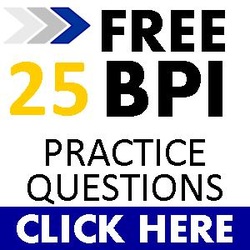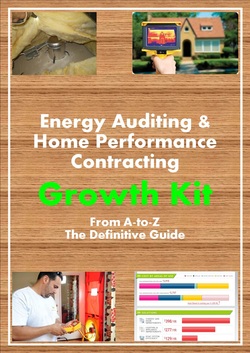Passing the BPI Exam With Energy Auditor Training
FREE BPI PRACTICE EXAMPUT YOUR HOME PERFORMANCE BUSINESS ON ROCKET FUELENERGY AUDITOR NEWSLETTERGet the only Energy Auditor Marketing Newsletter with monthly strategies and tactics to grow your home performance business.
|
BPI Written Exam - Section 1 Building Science Fundamentals15. Understand Pressure Boundary
There are two important boundaries to know for the BPI exam and during a career in home performance. The first is a thermal boundary and the second is a pressure boundary. The thermal boundary is boundary between the inside and the outside of the house as defined with insulation and an air barrier. You need both (insulation + air barrier) 100% in contact with each other for a proper thermal boundary. A lot of energy audits and home performance upgrades involves finding and correctly aligning these two together... more on this in the Thermal Boundary section.
The second term, pressure boundary, has to do with the connectivity of the house to the:
An important point to remember is that two things drive air leakage.
Take either of those two things away and you have solved your air leakage problem. In many cases, it is impossible to eliminate all the possible causes of a pressure difference so air sealing the holes and gaps is our only option. That's why finding where our pressure boundary is, is so important. The connections (aka holes in the wall) happen in more obvious places like canned lights, top plate leakage, missing top plates, electrical penetrations and also in not so obvious places like duct chases, basements, crawlspaces, behind stair chases, behind air handler closets or wall cavities that can only be found by using pressure diagnostics. Imagine a two story, 4000 sq ft house with both AHU in the attic, a bonus room above the garage and soffits and arches over every room. By using pressure mapping we can discover without even going into the attic...
We can measure how well connected each of these is with pressure mapping. There are several ways to do pressure mapping depending on the questions you have for each home. Some tests should be done on every house, some only if you have an attached garage for example, but here is a run down of the different pressure mapping tests. All these test require a manometer and most require the use of a blower door depressurized / pressurized to 50 Pa. RulesIf you know the pressure reading of one zone, you automatically know the reading of the corresponding zone. This is because we always have the blower door running at 50 Pa. It is easier for me to write this out in a formula, where:
Pressure A + Pressure B = 50 Pa Pressure A is the zone that we choose to get a pressure pan reading from, whether it be an electrical outlet, a small hole we drill in a soffit, the ductwork after we tape all the registers shut and insert our tube or by removing the attic hatch (pressurize so you don't suck insulation) When measuring pressure boundaries, a zone can be any room, attic, crawlspace, outside or basement. We always measure a zone with respect to (WRT) another zone. For example we measure the room pressures of each room with respect to the outside. Zonal / zone pressure mappingThis tells us if the zone we are measuring is more inside or outside. Zones can be taken out canned lights, electrical outlets, entire rooms or by drilling a small hole in a soffit or wall cavity and sticking our tube in.
0 - 10 Pa = minimal leakage 11 - 39 Pa = confused area. Yes this is a large range but the higher you go, the more leaks or bigger the connect is to the outside 40 - 50 Pa = outside Next Section
1b. Principals of energy, air & moisture
1c. Combustion science
|
The main topics of the BPI BA exam are listed out below. Click on a link that interests you, or you need some brushing up on to learn more on each subject.
1. Building Science Fundamentals 1a. Basic terms and definitions 1b. Principals of energy, air & moisture 1c. Combustion science 2. Buildings and Their Systems 2a. Building components 2b. Conservation strategies 2c. Comprehensive building assessment process 2d. Design considerations 3. Measurement and Verification of Building Performance 3a. Applied diagnostics and troubleshooting 4. BPI National Standards and Project Specifications 4a. Comprehensive building assessment 5. Analyzing Buildings Systems 5a. Comprehensive building assessment 5b. Appliances and lighting 6. Conduct and communications 6a. Conservation strategies |

